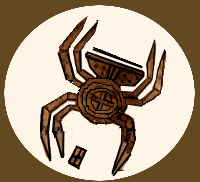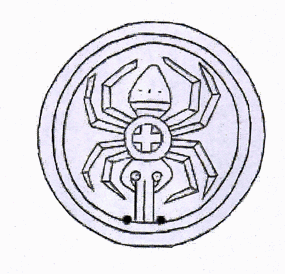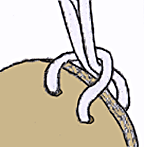Spiders
in Native American Culture.
The spider was an important symbol to the people of the Mississippian
culture. Archaeologists think that the cross is a symbol of fire,
the sun, the center of the earth, or the four directions (north, south,
east, west). The body of the spider also forms a cross, with four
groups of two legs each coming out of the body. The spider symbol
was especially associated with women. It is thought that the spider
symbolizes weaving, fertility, the center of the earth, balance, and
harmony.
Materials:
self-hardening clay (2" ball per student) pointed stick or pencil
point 30-inch cord
Procedure:
see instruction sheet (and print out of patterns in pdf version).
Assessment:
After reading the introduction, discussing the section on gorgets
and trade in the Web module, and making the gorget, the students should
be able to tell or write about the symbolism, trading for shell, the
use of the object, and how archaeologists learn about such objects
as this.
Resources:
Childress, Diana. Prehistoric Peoples of North America. Chelsea
House, 1995. Covers the Paleo-Indians' migration across Beringia to
Alaska.
Nichols, Peter. Mastodont Hunters to Mound Builders: North American
Archaeology. Sunbelt Media. 1993. Ages 11-12.
Pickering,
Robert B. The People. Millbrook Press. 1996. Ages 7-9. Wheat,
Patricia. Clues to the Past: A Resource Book on Archaeology. Hendrick,
L., 1995.
Illinois
Goals and Standards addressed:
Visual Arts: Goal 27: Understand the role of the arts in civilizations,
past and present.
Standard B: Understand how the arts shape and reflect history,
society, and everyday life.
Social
Studies: Goal 18: Understand social systems (U.S.)
Standard A: Compare characteristics of culture as reflected
in the arts and traditions.
Instruction
Sheet:
 Make
a Mississippian-style Spider Gorget
Make
a Mississippian-style Spider Gorget
Gorgets
are pendants that are worn on the chest, hung from a string or a necklace.
Ancient Native Americans made gorgets of rare materials such as copper
or marine shell, which had to be obtained through trade. A number
of similar gorgets have been found throughout the Mississippi River
Valley and in the southeastern part of the United States.
Gorget Pattern #1
Spiders
in Native American Culture.
 The
spider was an important symbol to the people of the Mississippian
culture. Archaeologists think that the cross is a symbol of fire,
the sun, the center of the earth, or the four directions. The body
of the spider also forms a cross, with four groups of two legs each
coming out of the body. The spider symbol was especially associated
with women, perhaps symbolizing weaving, fertility, the center of
the earth, balance, and harmony.
The
spider was an important symbol to the people of the Mississippian
culture. Archaeologists think that the cross is a symbol of fire,
the sun, the center of the earth, or the four directions. The body
of the spider also forms a cross, with four groups of two legs each
coming out of the body. The spider symbol was especially associated
with women, perhaps symbolizing weaving, fertility, the center of
the earth, balance, and harmony.
Gorget
Pattern #2
Materials:
self-hardening clay
pointed stick or pencil point
30-inch cord
Steps:
1. Use a ball of clay about two inches in diameter. Flatten it out
into a disk about 1/4-inch thick.
2. Use a pencil point to lightly trace onto the clay the Mississippian
design of the spider, or adapt the design to one of a similar style
associated with Illinois Native Americans. Press lightly into the
clay so the design is engraved into the surface. The design will show
up when light shines across the gorget.
3. Use the pencil point to poke two holes through the gorget at the
top of the design about ½ inch from the edge. This is where you will
thread your cord.
4. Leave the gorget in a safe spot to dry (at least overnight). The
color should be lighter with no dark areas.
 5.
Thread one end of the cord through one hole from the front, and the
other end of the cord through the other hole from the front. Gently
pull the ends until there is only a loop at the front. Hold the ends
together and push them through the loop from back to front. Tighten
the cord.
5.
Thread one end of the cord through one hole from the front, and the
other end of the cord through the other hole from the front. Gently
pull the ends until there is only a loop at the front. Hold the ends
together and push them through the loop from back to front. Tighten
the cord.
6. Tie the two ends of the cord together at the tips. You now have
a necklace.

